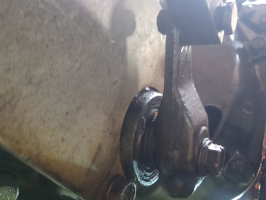Pete the Cat
Sustaining Member
The quality of the picture of the prop is not good enough on my computer to offer an overall opinion. Some pitting is normal and some nicks on the blades would not be a big deal but you can pick up a used fixed blade Campbell Sailor prop (which this is likely to be) for cheap second hand if that is a problem--lots of them around--you need to know the pitch and size. The blisters really do not look like a big deal either. They look to be between the gelcoat and substrate and this is common. They also may have been caused by someone putting on a "barrier coat" over the gelcoat and then trapping moisture between the layers--this would account for the widespread tiny blisters if I am gauging the size correctly--this is a common problem caused by boatyards and DIYers after the blister chaos of past decades. There is one bump (where the cluster of smaller bumps) in #37 I might puncture and see if the glass under it has been affected, but even then, I do not see anything that would worry me if the glass around it sounds OK. I have done a fair amount of bottom work in the 1980s and 90s. Blisters are mostly cosmetic issues even when they are severe (except Uniflite products from the 1980s where the blisters indicated delamination in some Valiant yachts). I am an anti barrier coat person--my view is that these products have caused more blisters than they have prevented--I cannot prove that--but I have seen it repeatedly in the boatyard.






